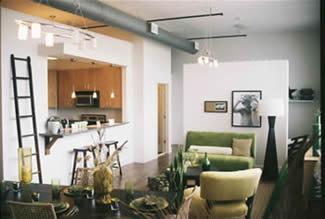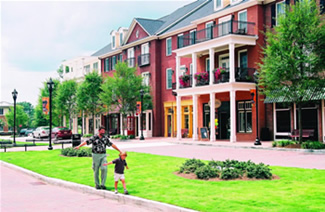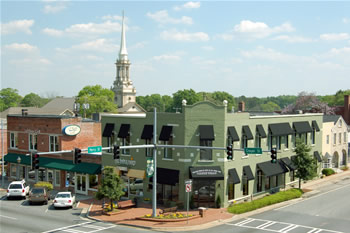 |
||||||||||||||||
|
|
||||||||||||||||
|
||||||||||||||||
|
Beyond Renovation
Atlanta, taken in its entirety, is a bustling metropolis with a strong urban core. However, with a population upwards of 5 million, the greater Atlanta area has in recent decades geographically expanded. Developments have filled up the formerly distinct surrounding cities and towns—and all the spaces in between. As newcomers, it may be easy to confuse one town with another, as suburban sprawl has muddied a community’s physical limits and characteristic attributes.
These years of unsustainable overdevelopment on the edges of towns and underutilization of the town itself have resulted in not a few adverse environmental impacts. Many have become frustrated with the area’s congestion. Seeking change, people young and old are moving back to re-emerging urban centers, hoping to better their quality of life while minimizing their environmental effect. Revitalization involves renovation, but for numerous cities and towns, revitalization is also about recreating a sense of place. “To some, revitalization is solely a result of understanding and applying ‘smart growth,’ utilizing existing structures, etc. However, it appears that in many cases, it is about recreating a community or redefining a city or place, both physically and characteristically,” says Emory Morsberger, founder and CEO of the Morsberger Group, a redevelopment firm in Atlanta. To combat the loss of identity due to rapid area growth; to bring business and residents back to their existing urban centers; and to recreate a sense of community, many cities and towns have created downtown development programs and joined state-supported and citywide initiatives such as the Main Street Program, which provides technical assistance and resources to improve a community’s commercial district and maintain its historic integrity. The Livable Centers Initiative (LCI) was created in 2000 by the Atlanta Regional Commission to promote sustainable, livable communities—connecting homes, shops and offices; enhancing pedestrian-friendly streetscapes; improving access to transit options; and expanding housing options in community centers. Many cities and towns in and around Atlanta have benefited from these programs, and through various other efforts, made massive strides in bringing residents, and life, back to their communities. So when looking to buy your new home, the unique developments and niche neighborhoods of these revitalized cities are a great place to start. Hapeville
Two other projects currently underway in Hapeville are Old Towne and Arlington, both projects from Main Street Partner Group LLC (www.mainstreetpartnergroup.com). Old Towne, a $30-million development, is planned as an urban village—complete with sidewalks and green space—of more than 30 acres. With its estimated 1,200 new residences, including townhomes and condominiums, Old Towne is intended to help anchor the revitalization of South Hapeville. In the first phase of the development, prices for the homes will range from the high $100s to the $300s. Arlington, in contrast, will be a high-end, 30,000-square-foot mixed-use development offering both retail and residential lofts. Smyrna
Jonquil Village (www.jonquilvillage.com) is another development on the horizon for Smyrna. As one of Smyrna’s new gateways to the city, the proposed development will include 160,000 square feet of retail space, 20,000 square feet of office space and between 250 and 300 luxury condominiums.
Lawrenceville
In the course of just one year, 20 new businesses opened—a bridal shop, a stationery shop, antique shops, clothing stores and even a bakery are now located in downtown Lawrenceville. And in May 2007, the Aurora Theatre opened in its new space on historic Lawrenceville square. Downtown Lawrenceville will soon offer both luxury condominium and townhouse residences that overlook the square in a mixed-use development from the Morsberger Group. Residents will enjoy secured parking, a clubhouse, rooftop terrace and street-level restaurants and cafés. Expected to be finished in 2008, each condo or townhouse will be approximately 1,200 square feet with prices beginning around $225,000. Bringing people back to the town center through revitalization also brings people together with a sense of community. By carving new homes and developments out of a city’s past, revitalization not only helps to ensure a city’s economic viability and preserve its heritage, but it also serves to solidify its identity.
|
|
|||||||||||||||
|
|
||||||||||||||||











